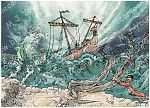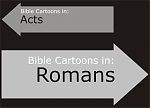Bible Cartoon: Acts 27 - Paul shipwrecked - Scene 07 - Everyone safe
Click on Add to cart button below shopping cart.
Purchased Bible Cartoons do not have watermarks. Links to Cartoons provided on email once purchase is completed.Bible Book: Acts
Bible Book Code: 4402704401
Scene no: 1 of 1
Bible Reference & Cartoon Description
Acts 27:44 (ANIV)
The rest [of the ship’s company] were to get there [safely ashore] on planks or on pieces of the ship. In this way everyone reached land in safety.
DRAWING NOTES:
TIME OF DAY:
Verse 39 says “When daylight came” (after the night), so this scene is set in the very early morning.
LIGHTING NOTES:
Although I have set this scene in the early morning, the storm clouds are completely obscuring the sun, so that it looks like a night scene. The storm’s lightning provides the bright white light of the scene.
CHARACTERS PRESENT:
In the foreground, on the beach is the apostle Paul. Various people can be seen in the waves, dragging themselves to shore.
RESEARCH/ADDITIONAL NOTES:
Verse 41 tells us that “the stern was broken to pieces by the pounding of the surf.” So clearly at this time the storm was still raging. You can see I have drawn a powerful wave smashing into the stern (back) of the ship. I enjoyed drawing & colouring up the sky & pounding, energetic waves in this scene.
This picture was actually first drawn for one of my “Bad Day” mug designs, but I soon realised that I could colour it up into a dramatic scene worthy of inclusion in the Bible Cartoons collection!
The colouring of Paul’s skin, hair & clothes is taken from earlier cartoons, most notably Acts 09 – Paul in Jerusalem – Scene 01 – Advocate. I like to use similar colouring between different scenes & between different stories which depicting the same character, since that maintains colour continuity across all the narratives. Having said that, I will often adjust colours slightly due to the local lighting effects of any given scene. In this scene the apostle Paul is depicted in quite dark greens, a result of being soaked to the skin & only illuminated by the lightning in this dark, stormy environment.
Notice the frayed edges of Paul’s outer robe, near his feet, which illustrate the violence of the storm on his clothes.
Some searching on the internet provided pictures of ships from the right region & era for this scene. Notice the mast has had it’s top broken off in my picture.
I researched the geology & nature of the beaches of Malta to help me select suitable colours for the beach, although the pale yellow rocks & beach can hardly be made out in the gloom of the stormy conditions! According to the geological map of Malta the region of St. Thomas Bay (a large bay in the South of Malta, where this scene is set) is Middle Globigerina Limestone. This pale yellow rock weathers into gentle slopes, rather than the underlying, harder Coralline Limestone, which forms impressive, high angle cliffs.
Notes about the Globigerina Limestone Formation, for those interested!
“2.4.2. Globigerina Limestone Formation
Murray (1890) was the first to use this name and followed by other authors. The thickness of this formation varies from 25 to 60 meters. It consists of a sequence of a yellow pale micritic limestone subdivided into 3 members: Lower Globigerina Limestone, Middle Globigerina Limestone and Upper Globigerina Limestone (Félix, 1973). The limit between the Lower Globigerina Limestone and the Middle Globigerina Limestone is marked by a phosphatized hardground. A level rich in phosphate pebbles separates the Middle and the Upper Globigerina Limestone (Fig. 2.6).
The base of the Lower Globigerina Limestone coincides with a horizon rich in echinoids like Scutella. This member consists of yellow cream limestone in massive banks. Locally, very bioturbated levels occur, shown by a honeycomblike structure. The top of this member is covered by a phosphatized hardground of about 15 centimeters thickness. This hardground covers levels (1-3) of phosphatized pebbles and fossils, like molluscs, bivalves, shark teeth (e.g.: Carcharodon megalodon) and solitary corals.
The Middle Globigerina Limestone has a thickness which reaches 16 meters and consists of white to yellow pale marly limestones. It contains rare macrofossils like bivalves (Chlamys, Flabellipecten). This member locally possesses horizons which contain phosphate pebbles. The number of horizons varies between 0 and 4. The top of this member is marked by a level which is very rich in phosphate pebbles and fossils. This level has a thickness which reaches one meter and it may be duplicated. The fossil content is the same as of the banks underneath the hardground.
Finally the Upper Globigerina Limestone has a thickness which reaches maximally 18 meters. It consists of sandy limestones with a fauna which consists especially of foraminifera and bivalves. The macrofauna is very sparse. This member is marked by an interval of blue marls which are very similar to the overlying Blue Clay Formation. The thickness of this interval is about 2 meters. Then the limit with the Blue Clay Formation is transitional.”
[Source: ftp://ftp.unine.ch/Bouzelboudjen/Gertsch_Dipl_Oct2004/Links/Chapter2.pdf]





